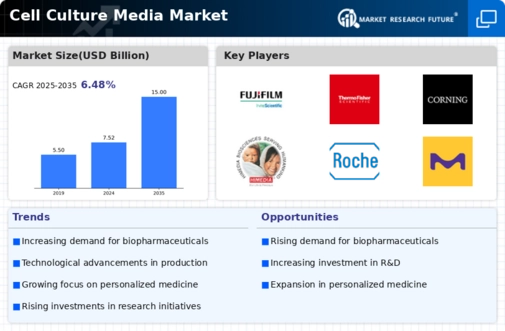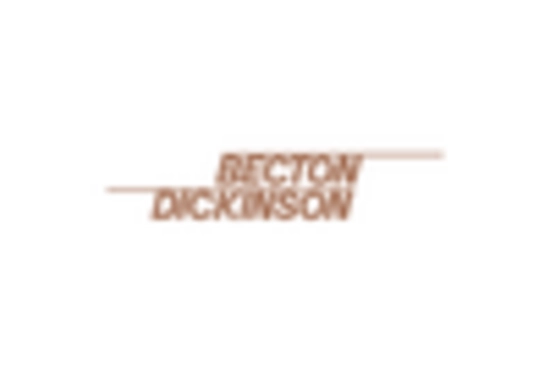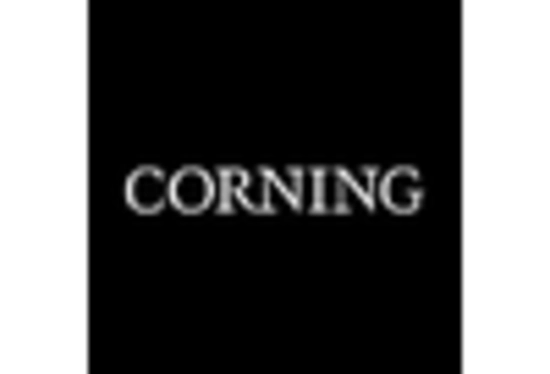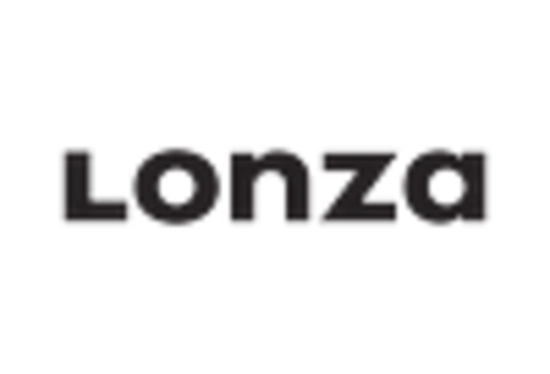Basal Media
Supplemented Media
Serum-Free Media
Defined Media
Biopharmaceutical Production
Tissue Engineering
Regenerative Medicine
Cancer Research
Academic Research
Pharmaceutical Companies
Biotechnology Companies
CROs
Liquid Media
Powder Media
North America
Europe
South America
Asia Pacific
Middle East and Africa
North America Outlook (USD Billion, 2019-2035)
North America Cell Culture Media Market by Type
Basal Media
Supplemented Media
Serum-Free Media
Defined Media
North America Cell Culture Media Market by Application Type
Biopharmaceutical Production
Tissue Engineering
Regenerative Medicine
Cancer Research
North America Cell Culture Media Market by End Use Type
Academic Research
Pharmaceutical Companies
Biotechnology Companies
CROs
North America Cell Culture Media Market by Formulation Type
Liquid Media
Powder Media
North America Cell Culture Media Market by Regional Type
US
Canada
US Outlook (USD Billion, 2019-2035)
US Cell Culture Media Market by Type
Basal Media
Supplemented Media
Serum-Free Media
Defined Media
US Cell Culture Media Market by Application Type
Biopharmaceutical Production
Tissue Engineering
Regenerative Medicine
Cancer Research
US Cell Culture Media Market by End Use Type
Academic Research
Pharmaceutical Companies
Biotechnology Companies
CROs
US Cell Culture Media Market by Formulation Type
Liquid Media
Powder Media
CANADA Outlook (USD Billion, 2019-2035)
CANADA Cell Culture Media Market by Type
Basal Media
Supplemented Media
Serum-Free Media
Defined Media
CANADA Cell Culture Media Market by Application Type
Biopharmaceutical Production
Tissue Engineering
Regenerative Medicine
Cancer Research
CANADA Cell Culture Media Market by End Use Type
Academic Research
Pharmaceutical Companies
Biotechnology Companies
CROs
CANADA Cell Culture Media Market by Formulation Type
Liquid Media
Powder Media
Europe Outlook (USD Billion, 2019-2035)
Europe Cell Culture Media Market by Type
Basal Media
Supplemented Media
Serum-Free Media
Defined Media
Europe Cell Culture Media Market by Application Type
Biopharmaceutical Production
Tissue Engineering
Regenerative Medicine
Cancer Research
Europe Cell Culture Media Market by End Use Type
Academic Research
Pharmaceutical Companies
Biotechnology Companies
CROs
Europe Cell Culture Media Market by Formulation Type
Liquid Media
Powder Media
Europe Cell Culture Media Market by Regional Type
Germany
UK
France
Russia
Italy
Spain
Rest of Europe
GERMANY Outlook (USD Billion, 2019-2035)
GERMANY Cell Culture Media Market by Type
Basal Media
Supplemented Media
Serum-Free Media
Defined Media
GERMANY Cell Culture Media Market by Application Type
Biopharmaceutical Production
Tissue Engineering
Regenerative Medicine
Cancer Research
GERMANY Cell Culture Media Market by End Use Type
Academic Research
Pharmaceutical Companies
Biotechnology Companies
CROs
GERMANY Cell Culture Media Market by Formulation Type
Liquid Media
Powder Media
UK Outlook (USD Billion, 2019-2035)
UK Cell Culture Media Market by Type
Basal Media
Supplemented Media
Serum-Free Media
Defined Media
UK Cell Culture Media Market by Application Type
Biopharmaceutical Production
Tissue Engineering
Regenerative Medicine
Cancer Research
UK Cell Culture Media Market by End Use Type
Academic Research
Pharmaceutical Companies
Biotechnology Companies
CROs
UK Cell Culture Media Market by Formulation Type
Liquid Media
Powder Media
FRANCE Outlook (USD Billion, 2019-2035)
FRANCE Cell Culture Media Market by Type
Basal Media
Supplemented Media
Serum-Free Media
Defined Media
FRANCE Cell Culture Media Market by Application Type
Biopharmaceutical Production
Tissue Engineering
Regenerative Medicine
Cancer Research
FRANCE Cell Culture Media Market by End Use Type
Academic Research
Pharmaceutical Companies
Biotechnology Companies
CROs
FRANCE Cell Culture Media Market by Formulation Type
Liquid Media
Powder Media
RUSSIA Outlook (USD Billion, 2019-2035)
RUSSIA Cell Culture Media Market by Type
Basal Media
Supplemented Media
Serum-Free Media
Defined Media
RUSSIA Cell Culture Media Market by Application Type
Biopharmaceutical Production
Tissue Engineering
Regenerative Medicine
Cancer Research
RUSSIA Cell Culture Media Market by End Use Type
Academic Research
Pharmaceutical Companies
Biotechnology Companies
CROs
RUSSIA Cell Culture Media Market by Formulation Type
Liquid Media
Powder Media
ITALY Outlook (USD Billion, 2019-2035)
ITALY Cell Culture Media Market by Type
Basal Media
Supplemented Media
Serum-Free Media
Defined Media
ITALY Cell Culture Media Market by Application Type
Biopharmaceutical Production
Tissue Engineering
Regenerative Medicine
Cancer Research
ITALY Cell Culture Media Market by End Use Type
Academic Research
Pharmaceutical Companies
Biotechnology Companies
CROs
ITALY Cell Culture Media Market by Formulation Type
Liquid Media
Powder Media
SPAIN Outlook (USD Billion, 2019-2035)
SPAIN Cell Culture Media Market by Type
Basal Media
Supplemented Media
Serum-Free Media
Defined Media
SPAIN Cell Culture Media Market by Application Type
Biopharmaceutical Production
Tissue Engineering
Regenerative Medicine
Cancer Research
SPAIN Cell Culture Media Market by End Use Type
Academic Research
Pharmaceutical Companies
Biotechnology Companies
CROs
SPAIN Cell Culture Media Market by Formulation Type
Liquid Media
Powder Media
REST OF EUROPE Outlook (USD Billion, 2019-2035)
REST OF EUROPE Cell Culture Media Market by Type
Basal Media
Supplemented Media
Serum-Free Media
Defined Media
REST OF EUROPE Cell Culture Media Market by Application Type
Biopharmaceutical Production
Tissue Engineering
Regenerative Medicine
Cancer Research
REST OF EUROPE Cell Culture Media Market by End Use Type
Academic Research
Pharmaceutical Companies
Biotechnology Companies
CROs
REST OF EUROPE Cell Culture Media Market by Formulation Type
Liquid Media
Powder Media
APAC Outlook (USD Billion, 2019-2035)
APAC Cell Culture Media Market by Type
Basal Media
Supplemented Media
Serum-Free Media
Defined Media
APAC Cell Culture Media Market by Application Type
Biopharmaceutical Production
Tissue Engineering
Regenerative Medicine
Cancer Research
APAC Cell Culture Media Market by End Use Type
Academic Research
Pharmaceutical Companies
Biotechnology Companies
CROs
APAC Cell Culture Media Market by Formulation Type
Liquid Media
Powder Media
APAC Cell Culture Media Market by Regional Type
China
India
Japan
South Korea
Malaysia
Thailand
Indonesia
Rest of APAC
CHINA Outlook (USD Billion, 2019-2035)
CHINA Cell Culture Media Market by Type
Basal Media
Supplemented Media
Serum-Free Media
Defined Media
CHINA Cell Culture Media Market by Application Type
Biopharmaceutical Production
Tissue Engineering
Regenerative Medicine
Cancer Research
CHINA Cell Culture Media Market by End Use Type
Academic Research
Pharmaceutical Companies
Biotechnology Companies
CROs
CHINA Cell Culture Media Market by Formulation Type
Liquid Media
Powder Media
INDIA Outlook (USD Billion, 2019-2035)
INDIA Cell Culture Media Market by Type
Basal Media
Supplemented Media
Serum-Free Media
Defined Media
INDIA Cell Culture Media Market by Application Type
Biopharmaceutical Production
Tissue Engineering
Regenerative Medicine
Cancer Research
INDIA Cell Culture Media Market by End Use Type
Academic Research
Pharmaceutical Companies
Biotechnology Companies
CROs
INDIA Cell Culture Media Market by Formulation Type
Liquid Media
Powder Media
JAPAN Outlook (USD Billion, 2019-2035)
JAPAN Cell Culture Media Market by Type
Basal Media
Supplemented Media
Serum-Free Media
Defined Media
JAPAN Cell Culture Media Market by Application Type
Biopharmaceutical Production
Tissue Engineering
Regenerative Medicine
Cancer Research
JAPAN Cell Culture Media Market by End Use Type
Academic Research
Pharmaceutical Companies
Biotechnology Companies
CROs
JAPAN Cell Culture Media Market by Formulation Type
Liquid Media
Powder Media
SOUTH KOREA Outlook (USD Billion, 2019-2035)
SOUTH KOREA Cell Culture Media Market by Type
Basal Media
Supplemented Media
Serum-Free Media
Defined Media
SOUTH KOREA Cell Culture Media Market by Application Type
Biopharmaceutical Production
Tissue Engineering
Regenerative Medicine
Cancer Research
SOUTH KOREA Cell Culture Media Market by End Use Type
Academic Research
Pharmaceutical Companies
Biotechnology Companies
CROs
SOUTH KOREA Cell Culture Media Market by Formulation Type
Liquid Media
Powder Media
MALAYSIA Outlook (USD Billion, 2019-2035)
MALAYSIA Cell Culture Media Market by Type
Basal Media
Supplemented Media
Serum-Free Media
Defined Media
MALAYSIA Cell Culture Media Market by Application Type
Biopharmaceutical Production
Tissue Engineering
Regenerative Medicine
Cancer Research
MALAYSIA Cell Culture Media Market by End Use Type
Academic Research
Pharmaceutical Companies
Biotechnology Companies
CROs
MALAYSIA Cell Culture Media Market by Formulation Type
Liquid Media
Powder Media
THAILAND Outlook (USD Billion, 2019-2035)
THAILAND Cell Culture Media Market by Type
Basal Media
Supplemented Media
Serum-Free Media
Defined Media
THAILAND Cell Culture Media Market by Application Type
Biopharmaceutical Production
Tissue Engineering
Regenerative Medicine
Cancer Research
THAILAND Cell Culture Media Market by End Use Type
Academic Research
Pharmaceutical Companies
Biotechnology Companies
CROs
THAILAND Cell Culture Media Market by Formulation Type
Liquid Media
Powder Media
INDONESIA Outlook (USD Billion, 2019-2035)
INDONESIA Cell Culture Media Market by Type
Basal Media
Supplemented Media
Serum-Free Media
Defined Media
INDONESIA Cell Culture Media Market by Application Type
Biopharmaceutical Production
Tissue Engineering
Regenerative Medicine
Cancer Research
INDONESIA Cell Culture Media Market by End Use Type
Academic Research
Pharmaceutical Companies
Biotechnology Companies
CROs
INDONESIA Cell Culture Media Market by Formulation Type
Liquid Media
Powder Media
REST OF APAC Outlook (USD Billion, 2019-2035)
REST OF APAC Cell Culture Media Market by Type
Basal Media
Supplemented Media
Serum-Free Media
Defined Media
REST OF APAC Cell Culture Media Market by Application Type
Biopharmaceutical Production
Tissue Engineering
Regenerative Medicine
Cancer Research
REST OF APAC Cell Culture Media Market by End Use Type
Academic Research
Pharmaceutical Companies
Biotechnology Companies
CROs
REST OF APAC Cell Culture Media Market by Formulation Type
Liquid Media
Powder Media
South America Outlook (USD Billion, 2019-2035)
South America Cell Culture Media Market by Type
Basal Media
Supplemented Media
Serum-Free Media
Defined Media
South America Cell Culture Media Market by Application Type
Biopharmaceutical Production
Tissue Engineering
Regenerative Medicine
Cancer Research
South America Cell Culture Media Market by End Use Type
Academic Research
Pharmaceutical Companies
Biotechnology Companies
CROs
South America Cell Culture Media Market by Formulation Type
Liquid Media
Powder Media
South America Cell Culture Media Market by Regional Type
Brazil
Mexico
Argentina
Rest of South America
BRAZIL Outlook (USD Billion, 2019-2035)
BRAZIL Cell Culture Media Market by Type
Basal Media
Supplemented Media
Serum-Free Media
Defined Media
BRAZIL Cell Culture Media Market by Application Type
Biopharmaceutical Production
Tissue Engineering
Regenerative Medicine
Cancer Research
BRAZIL Cell Culture Media Market by End Use Type
Academic Research
Pharmaceutical Companies
Biotechnology Companies
CROs
BRAZIL Cell Culture Media Market by Formulation Type
Liquid Media
Powder Media
MEXICO Outlook (USD Billion, 2019-2035)
MEXICO Cell Culture Media Market by Type
Basal Media
Supplemented Media
Serum-Free Media
Defined Media
MEXICO Cell Culture Media Market by Application Type
Biopharmaceutical Production
Tissue Engineering
Regenerative Medicine
Cancer Research
MEXICO Cell Culture Media Market by End Use Type
Academic Research
Pharmaceutical Companies
Biotechnology Companies
CROs
MEXICO Cell Culture Media Market by Formulation Type
Liquid Media
Powder Media
ARGENTINA Outlook (USD Billion, 2019-2035)
ARGENTINA Cell Culture Media Market by Type
Basal Media
Supplemented Media
Serum-Free Media
Defined Media
ARGENTINA Cell Culture Media Market by Application Type
Biopharmaceutical Production
Tissue Engineering
Regenerative Medicine
Cancer Research
ARGENTINA Cell Culture Media Market by End Use Type
Academic Research
Pharmaceutical Companies
Biotechnology Companies
CROs
ARGENTINA Cell Culture Media Market by Formulation Type
Liquid Media
Powder Media
REST OF SOUTH AMERICA Outlook (USD Billion, 2019-2035)
REST OF SOUTH AMERICA Cell Culture Media Market by Type
Basal Media
Supplemented Media
Serum-Free Media
Defined Media
REST OF SOUTH AMERICA Cell Culture Media Market by Application Type
Biopharmaceutical Production
Tissue Engineering
Regenerative Medicine
Cancer Research
REST OF SOUTH AMERICA Cell Culture Media Market by End Use Type
Academic Research
Pharmaceutical Companies
Biotechnology Companies
CROs
REST OF SOUTH AMERICA Cell Culture Media Market by Formulation Type
Liquid Media
Powder Media
MEA Outlook (USD Billion, 2019-2035)
MEA Cell Culture Media Market by Type
Basal Media
Supplemented Media
Serum-Free Media
Defined Media
MEA Cell Culture Media Market by Application Type
Biopharmaceutical Production
Tissue Engineering
Regenerative Medicine
Cancer Research
MEA Cell Culture Media Market by End Use Type
Academic Research
Pharmaceutical Companies
Biotechnology Companies
CROs
MEA Cell Culture Media Market by Formulation Type
Liquid Media
Powder Media
MEA Cell Culture Media Market by Regional Type
GCC Countries
South Africa
Rest of MEA
GCC COUNTRIES Outlook (USD Billion, 2019-2035)
GCC COUNTRIES Cell Culture Media Market by Type
Basal Media
Supplemented Media
Serum-Free Media
Defined Media
GCC COUNTRIES Cell Culture Media Market by Application Type
Biopharmaceutical Production
Tissue Engineering
Regenerative Medicine
Cancer Research
GCC COUNTRIES Cell Culture Media Market by End Use Type
Academic Research
Pharmaceutical Companies
Biotechnology Companies
CROs
GCC COUNTRIES Cell Culture Media Market by Formulation Type
Liquid Media
Powder Media
SOUTH AFRICA Outlook (USD Billion, 2019-2035)
SOUTH AFRICA Cell Culture Media Market by Type
Basal Media
Supplemented Media
Serum-Free Media
Defined Media
SOUTH AFRICA Cell Culture Media Market by Application Type
Biopharmaceutical Production
Tissue Engineering
Regenerative Medicine
Cancer Research
SOUTH AFRICA Cell Culture Media Market by End Use Type
Academic Research
Pharmaceutical Companies
Biotechnology Companies
CROs
SOUTH AFRICA Cell Culture Media Market by Formulation Type
Liquid Media
Powder Media
REST OF MEA Outlook (USD Billion, 2019-2035)
REST OF MEA Cell Culture Media Market by Type
Basal Media
Supplemented Media
Serum-Free Media
Defined Media
REST OF MEA Cell Culture Media Market by Application Type
Biopharmaceutical Production
Tissue Engineering
Regenerative Medicine
Cancer Research
REST OF MEA Cell Culture Media Market by End Use Type
Academic Research
Pharmaceutical Companies
Biotechnology Companies
CROs
REST OF MEA Cell Culture Media Market by Formulation Type
Liquid Media
Powder Media

















Leave a Comment